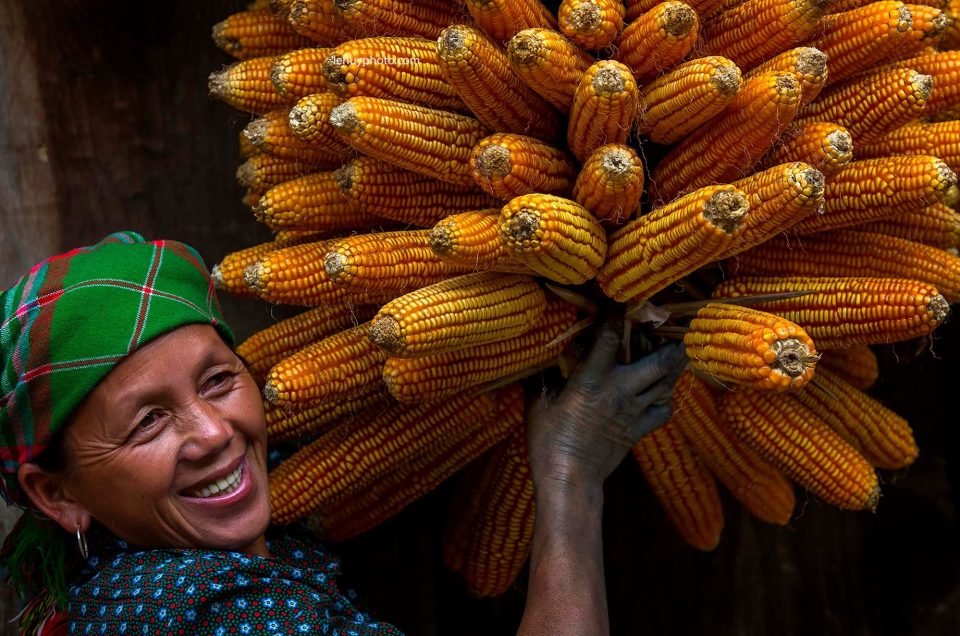Harvest happiness
“Joyful harvest days in the village and in the fields…
Carrying layers of golden rice home,
Carrying golden rice on the dike, in the early mornings.”
(Excerpt from the song “Harvest days” by Van Cao)

Only by experiencing the golden season can one truly appreciate the joy in the eyes and smiles of farmers when their rice hangs heavy with ripe grains.
The hardships of toiling in sun and mist, dripping with sweat, are rewarded by the delight of ripe rice in the fields, rice lining the village paths, and rice drying in the yards in front of farmers’ homes.
Warmed by the sun
Not long ago, Pu Luong was known merely as a nature reserve that was less renowned than those of Cuc Phuong or Ba Be. Today, this destination has become a bustling tourist spot. Set amidst primeval forests, where the Ma River flows gently and sometimes roars, Pu Luong is isolated from modern life. Visitors will find peaceful scenes of terraced fields, waterwheels, and stilt houses where smoke from straw fires drifts from the kitchens.

While hotels, resorts, and homestays are being built even in remote villages, Pu Luong still retains the essence of centuries past. The region’s indigenous Thai people have their own way of life, preserving traditional farming and animal husbandry methods and customs typical of this mountainous area. This distinct local culture sets Pu Luong apart from other tourist destinations that have exploded in popularity, like Sa Pa, Bac Ha, and Phu Quoc.

The two golden rice seasons in June and September attract photographers from throughout Vietnam and abroad. Unlike the grand terraces of Mu Cang Chai (Yen Bai), the terraced fields in Pu Luong are small and charming. Scattered along the hillsides, encircling villages, and nestled under forest canopies, they appear unexpectedly around each bend.

Visitors are amazed by the clusters of bamboo waterwheels in Ban Cong commune, which creak day and night, channeling the stream’s water from low to high fields. These scenes form precious backdrops for photographers, especially if they chance upon young women in traditional ethnic attire relaxing by the mountains’ rotating water wheels.

Returning to Pu Luong’s terraced fields, people delight in the golden season when picturesque and dreamy clusters of rice shine under the sun. The locals claim that the rice fields are more beautiful in June than in September, but visitors find Pu Long breathtaking in every season, especially when walking or cycling on the paths that link one village to another. After hours of tirelessly photographing the rice fields and chasing the clouds, it’s pure bliss to return to a stilt house, inhale the faint aroma of rice cooking on a wood stove, and invite each other to enjoy dishes that taste of the mountains.

Local specialties include new rice served with mountain snails steamed with ginger, bagrid catfish cooked with sour bamboo shoots, and Bangana lemassoni fish stuffed with herbs and spices like lemongrass, shallots, wild pepper, and doi seeds before being wrapped in banana leaves and grilled until crisp. Drivers and guides often hail Co Lung duck as the area’s best dish, while those with a taste for exotic flavors love khau nhuc, a type of braised pork typical of the border region. Perhaps the simplest yet most endearing flavor is that of new rice, whether sticky or ordinary, which exudes a nostalgic and fairytale-like scent when cooked over a hot fire.
Golden fields & green pearls
Vietnamese people have long associated Hanoi’s autumn with cốm—young green sticky rice flakes—from Vong village, located in Dich Vong Hau Ward in Hanoi.
However, this autumn, if you welcome the golden season in the Northern Highlands, follow the sounds of pestles pounding cốm in the villages to discover a delightful snack brimming with rustic emotions from the fields and mountains.

Throughout the Northwest and Northeast, wherever there is new sticky rice, the locals are busy harvesting, winnowing, and rhythmically pounding the green kernels to produce “green pearls” that carry the fragrance of the countryside and the autumn hills.

The route to Yen Bai province always captivates visitors during the golden season, especially when passing through Tu Le commune in Van Chan district. This beautifully named town lies nestled in a valley between three high mountains: Khau Song, Khau Pha, and Khau Than. The locals have long adapted to the steep terrain and cultivate rice on terraced fields. Among the various types of rice grown in Tu Le, the traditional sticky rice is ranked among the best in Vietnam, known for its aroma, delicious taste, and richness. Only planted once a year, this rice creates a famous specialty called “cốm Tu Le”. Naturally, good sticky rice yields good young sticky rice flakes. From mid-August to mid-October, when the locals start harvesting sticky rice, the “green sticky rice kilns” are busy in every village.

We didn’t have to go far, spotting a “Cốm Tu Le” sign on a house along the town’s main road, where we stopped to learn about their production process. The local ethnic Thai people are very hospitable, always greeting visitors with smiles. They explained that the rice chosen for young sticky rice snacks must be harvested at dawn when the grains are still soaked in dew. The heavy ears of rice should have plump, firm grains covered in a golden-blue husk, with a bit of milk at the tip. The rice is brought home for preliminary processing: threshing, winnowing, rinsing with clean water, and roasting in an iron pan.

The roasting is the most crucial step as the cook must control the heat, manage the timing, and constantly stir the grains so that they gradually shed their husks. The cooked grains are spread out to cool and pounded in a mortar. The rustic mortars and pestles fascinate visitors from the lowlands, who eagerly ask to try them out. The mortar is made of stone, and the pestle is wooden, operated by foot via a horizontal beam. One person steps on the beam to pound the rice in the stone mortar, while another stirs the rice to ensure it’s evenly pounded. This rhythmic process continues until all of the husks are removed. The round, flat grains are sifted one last time before being wrapped in fresh green dong leaves.

Visitors are delighted to sample the warm, fragrant, and soft flakes of cốm straight from the kiln. Without a word, everyone quickly buys some, fearing this delicious treat might run out. The locals earn extra income with their famous cốm Tu Le, which inspires them to expand their sticky rice cultivation and production areas. For the people of Tu Le, making green sticky rice flakes is not just a traditional craft but a way to improve their lives.





